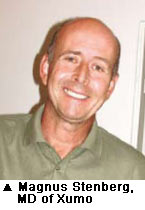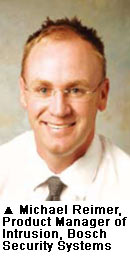With the recession still looming, the industry turns to basic solutions with proven results. Video verification integrates alarms with cameras, fusing their strengths for clear security.
Using multiple sensors is not new, but recent products reflect a true marriage between alarm and video. Adding surveillance to sensors verifies alerts at the edge, determining whether first responders are needed.
The global crisis is forcing monitoring stations to break with technological conservatism, and video verification is a game-changing technology. "Despite the relatively flat market for intrusion detection systems, we are seeing a 50 percent annual growth," said Francois Lafferriere, Director of Business Development, RSI Video Technologies.
Customers realize the strength of fusing sensors and algorithms into a single, coherent solution, said Hagai Katz, GM and VP of Marketing of Magal S3. It is not only for accuracy, as intrusion detection battles false alarms, but also decreases response time.
"This will improve client satisfaction and decrease the operating cost of the monitoring station," Lafferriere said. Moreover, privacy features can record only when the alarm system is activated, eliminating the concern of constant  surveillance, said Uri Engelsman, VP of Sales and Marketing, Pima Electronic Systems.
surveillance, said Uri Engelsman, VP of Sales and Marketing, Pima Electronic Systems.
Faster Response
There are two complementary approaches to decrease response time: minimizing the time for the operator to receive and process an alarm, or decreasing the time for patrol to reach the site. "With standard systems, response teams lose valuable time and money by investigating false alarms, which occur about 99 percent of the time," Lafferriere said.
When an alarm is triggered, this tool can achieve both means. Alarm and video can be simultaneously received through GPRS, Lafferriere said. The video-verified alarm then becomes much easier to work with than blind alarms — there is no need to call the site to confirm the intrusion or complicate the work of the operator by accessing a local video on-site. A video of the alarm event would suffice for users to determine if further action is necessary. The CMS can also automatically forward the video to the user's e-mail or cellular phone, Lafferriere said.
Other vendors may choose to breakdown the process. When an alarm is triggered, response time can be decreased by sending an immediate SMS t the user because it is the quickest. Right after the SMS, the system sends MMS and e-mail to the user to verify if the alarm is legitimate. In addition, user can make a  phone call to the system to further verify the alarm by engaging in a two way audio conversation and the user can immediately go to his or her browser to connect live with the unit, said Magnus Stenberg, MD of Xumo.
phone call to the system to further verify the alarm by engaging in a two way audio conversation and the user can immediately go to his or her browser to connect live with the unit, said Magnus Stenberg, MD of Xumo.
Joining Technologies
The alarm and video verification market splits into two basic solutions: single and separate devices. With single devices, alarm and video are joined into one unit and are typically used indoors, for commercial and residential use. However, single devices are stationed outdoors as well, at construction sites, communication towers and so on. Where alarm and video are separate units but fused together into one system, outdoor perimeter protection is among its popular applications. Popular sensors are microwave, buried cable, IR and laser. Commonly deployed cameras feature CMOS image sensors, 1.3 megapixel resolution and MPEG-4 compression.
Single-Unit Sentries
An all-in-one unit will typically consist of an alarm, sensor (usually PIR) and camera connected to wireless sensors. "Putting the camera and sensor into one housing saves costs and guarantees that both the camera and sensor are in line with the viewing angle to achieve the best detection and image capturing result," Stenberg said.
Moreover, single units are less obtrusive, requiring less installation and configuration and are generally more aesthetically appealing, said Michael Reimer, Product Manager of Intrusion, Bosch Security Systems.
To adjust for low-ight conditions, built-in LEDs are deployed, as well as color  cameras with 3.4 lux lighting. Relays can control external lighting with color cameras, Reimer said.
cameras with 3.4 lux lighting. Relays can control external lighting with color cameras, Reimer said.
All devices should be wireless for ease of installation and ensuring power cut immunity. "Our system, including the panel, is autonomously battery-operated for up to four years on standard usage conditions," Lafferriere said. Additionally, the radio signal is bidirectional and secured through a 128-bit encryption key, which operates over several hundreds of meters for outdoor purposes. For outdoor applications, devices should be rated IP 65 to withstand trying environmental conditions.
Full Systems
For large outdoor installations, video-alarm systems cannot verify an intrusion alone. They must also locate and calculate the intrusion's dimensions, or its size and distance from the sensor. "This information can be shown on a virtual map, which gives the operator the precise location of an intruder over a distance of 200 meters," said Nicolas Jdanoff, Sales Director for IPVision (a Hymatom company).
PTZ cameras attached to the PIR sensor-embedded detection wall can be fed with four or five mirrors located in the wall, all of which reproduce the same image from different perspectives. Algorithms then analyze the different reflections and calculate the exact position of the intruder, Jdanoff said. Each sensor, individually triggered upon alarm, has a 60-degree angle composed of 15.4-degree beams. With six sensors spiralled on a pole, 360-degree coverage of the zone is achieved, allowing the camera to locate intruders.
An alternative to PIR sensors is the ranging buried cable sensor, which has pinpoint accuracy within a meter of the intrusion. If an intruder crosses a large site, the alarm is sent to the control center, while a camera simultaneously pans to where the intrusion was detected, Katz said.
IR illuminators for video surveillance or infrared cameras are used outdoors for low-light conditions, and many alarm vendors offer their own cameras. However,  almost no alarm manufacturers make cameras; they add their own accessories, algorithms and packaging for the cameras, Katz said.
almost no alarm manufacturers make cameras; they add their own accessories, algorithms and packaging for the cameras, Katz said.
With separate alarm and video components, storage may be expensive. New video alarm verification devices can support up to 16 analog cameras with one alarm system, Engelsman said. "In some similar systems, wireless or internet cameras are a must, which are more expensive with fewer bites. With newer devices, any analog or digital camera can be used, even those from existing video surveillance installations."
Finally, to future-proof sites for expansion, chosen units or systems must be easy to integrate. Some companies, such as RSI Video Technologies, allow registration of additional devices to the main control panel without cables or power.
Market Penetration
"Every alarm needs some sort of verification. Users will not blindly trust the alarm, and immediate video verification is the best approach," Stenberg said. Combining both alarm and cameras for video verification is a growing trend.
While how much growth is yet unknown, video verification is valuable and recognized for reducing false alarms and providing evidentiary material for monitoring companies as well as building occupants, Reimer said. The technology is now mature and more affordable, with costs almost comparable to a  blind alarm system. The future, therefore, for video verification devices is vast and unlimited, with potential to penetrate both alarm and video surveillance applications.
blind alarm system. The future, therefore, for video verification devices is vast and unlimited, with potential to penetrate both alarm and video surveillance applications.
Video verification is not to identify intruders with high-resolution video, but to confirm intrusions as quickly as possible to minimize response time, Lafferriere said. Controlling and archiving video footage from many sites can become cumbersome, while video verification captures only the critical information — the first seconds of an intrusion — to facilitate an immediate reaction.
Ultimately, these devices and systems bring the industry back to basics, as the viability and efficiency of an integrated security system is based on its level of qualified alarm events, Jdanoff said.